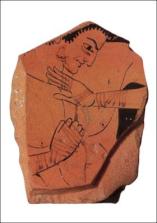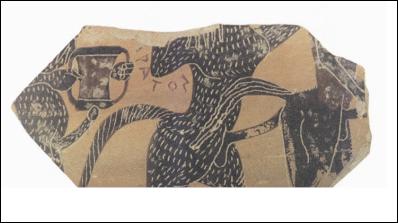Bob Hecht: Fragments Of An Antiquities Conspiracy?
Bob Hecht: Fragments Of An Antiquities Conspiracy?
By Suzan Mazur


(left)
Thracian boxer ----------<<< >>>>------------- Three
"ithyphallic" satyrs (right)
- click images for bigger versions -
Hugh Eakin’s recent "Treasure Hunt" story in The New Yorker profiling Marion True, the former Getty curator on trial in Rome for conspiracy to traffic in ancient art, devotes a column to True’s 1991 paper on the destruction of ancient cultural sites, giving the impression that the Italian government is to blame for looting half of that country’s Greek and Roman history because it may have neglected its sites – Eakin doesn't note that the entire country is an ancient site. Eakin also suggests that the Italians lack seriousness in prosecuting the two-year old antiquities trial in which dealers Bob Hecht and Giacomo Medici are named as co-conspirators – even though Medici's already been convicted, sentenced to ten years and is appealing the court's decision. Moreover, Eakin reduces Italy’s efforts in seeking the return of its cultural patrimony to a sports rivalry between the art carabinieri and ministry of culture – he doesn't illuminate that from the outset one faction fought to get the loot back from American museums with no strings attached, i.e., it did not want to cave in to the Metropolitan Museum of Art's demands for loans.
What New York Times contributor Hugh Eakin particularly fails to do is reveal names, details and sources of information in his 14-page New Yorker cover story -- even of the name of the editor of Connoisseur? Or give further insight into the actual looting and trafficking that’s taken place. And nowhere is there mention of the role played for decades by the NYT as an enabler of the trafficking, which Met Ancient Near East expert Oscar Muscarella first exposed years ago. [LINK Antiquities Whistleblower Oscar White Muscarella]
The above fragments, for example – which may serve as clues to the mindset of those charged in the Rome trial – were sold by Hecht in a 1988 Atlantis Antiquities Greek and Etruscan Archaic art show in New York that was highly publicized by the NYT. Times reporter Rita Reif barked dollar amounts in her pre-sale coverage, previously discussed on these pages [LINK Add NYT To Bob Hecht Antiquities Ring Organigram? ] – even of the exhibition’s fragments, noting a starting price of $500. Said Reif:
“Some of the richest detail is on fragments of painted vessels. Among the most compelling are. . .three headless satyrs. . . One of the smallest fragments in the show, less than two inches high, shows a tough-faced Thracian boxer scarred near the eye and jaw, with a hook nose and protruding chin, and with both hands visible – his right hand already wrapped while he draws the thong taut on his left.”
However the fragments that Reif described above in the NYT, and that are pictured at the top of this story, were never assigned a price on Hecht’s list at the time of the actual sale because by then they were already SOLD and disappeared into the market for an undisclosed amount.
Hecht pal and long-time Museum of Fine Arts curator of classical art, Cornelius Vermeule also promoted the sale, writing an introduction to Hecht’s catalog. Vermeule was one of Marion True’s early mentors and first introduced True to Bob Hecht, which Eakin surprisingly does mention in his article.
The boxer fragment Reif refers to (above, left) is from a red figured wine cup, 500 bc, proto-Panaitian painter. It indeed depicts the fierce profile of a boxer wrapping his hand. He bears a nasty scar under his eye and gash under his chin. And knowing what we now know about Bob Hecht’s history of thuggery, the fragment appears to be somewhat autobiographical. [LINK "Bully Bob" Hecht And The Euphronios Questions]
Hecht’s affection for and exhibition of the second piece on the right, three “ithyphallic” silenes (satyrs) reveling, painted by Sophilos, 570 bc, may be Hecht's personal statement about the conspiracy itself.
One of the silenes carries a drinking cup, a karchesion. Vermeule describes the procession as “woolly” and “charming” with “nymphs on their minds”. Or perhaps a Euphronios vase or two. . .
 Suzan
Mazur's stories on art and antiquities have been published
in The Economist, Financial Times, Connoisseur, Archaeology
(cover) and Newsday. Some of her other reports have
appeared on PBS, CBC and MBC. She has been a guest on
McLaughlin, Charlie Rose and various Fox television news
programs. Email: sznmzr@aol.com
Suzan
Mazur's stories on art and antiquities have been published
in The Economist, Financial Times, Connoisseur, Archaeology
(cover) and Newsday. Some of her other reports have
appeared on PBS, CBC and MBC. She has been a guest on
McLaughlin, Charlie Rose and various Fox television news
programs. Email: sznmzr@aol.com


 Gordon Campbell: DeepSeek, And China’s Inexorable Rise
Gordon Campbell: DeepSeek, And China’s Inexorable Rise Martin LeFevre - Meditations: History Is Not A Game
Martin LeFevre - Meditations: History Is Not A Game Peter Dunne: Dunne's Weekly - ACT Looks Backwards
Peter Dunne: Dunne's Weekly - ACT Looks Backwards Binoy Kampmark: Funeral Atmospherics At The British Library
Binoy Kampmark: Funeral Atmospherics At The British Library Ramzy Baroud: Dear World - This Is What Palestinian Unity Looks Like
Ramzy Baroud: Dear World - This Is What Palestinian Unity Looks Like Ian Powell: Reti’s Velvet Glove Wore Too Thin For PM’s Iron Fist
Ian Powell: Reti’s Velvet Glove Wore Too Thin For PM’s Iron Fist